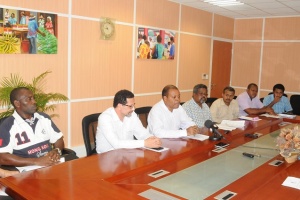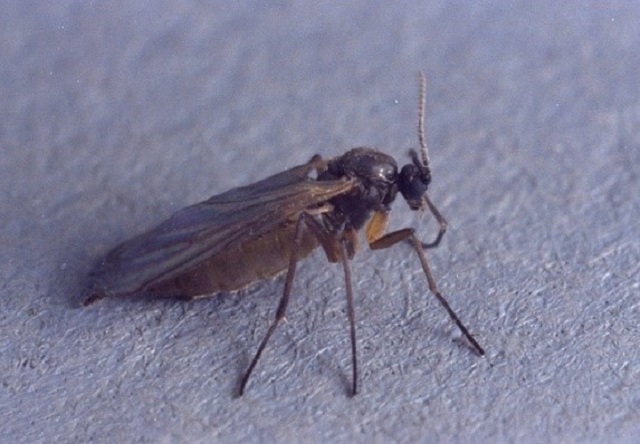Black fungus gnat species needs to be identified, Seychelles’ authorities say
General |Author: Salifa Magnan and Betymie Bonnelame | February 11, 2017, Saturday @ 13:41| 5079 views
Seychelles authorities and experts from the African Union in a press conference with the local media. (Joena Bonnelame, Seychelles News Agency)
(Seychelles News Agency) - Experts from the African Union (AU) are working with Seychelles' authorities to identify the species of black fungus gnats that is causing a nuisance in the island nation and come up with a management strategy.
The three experts are in Seychelles after President Danny Faure sought the AU’s assistance to deal with the gnat when he attended the AU Summit held in Addis Ababa, Ethiopia last week.
Talking to reporters earlier this week, Subramanian Sevgan, a senior scientist at the International Centre of Insect Physiology and Ecology (ICIPE) said, “Once the species is identified, the next step is to identify the breeding sites [which] are crucial to help target your management strategies.”
The chief executive of the National Bio Security Agency, Marc Naiken, said that they have already set up a short, medium and long term action strategies to gain control over the insect.
“Once the species is identified, we will be able to adopt sustainable methods to fight against the gnat -- biological, physical and cultural, and as last a resort, chemical,” said Naiken.
The population of the little black-winged fly which is not new to Seychelles has increased rapidly during recent months. They come out as soon as the lights are switched on and have been described by residents in several posts on social media as a nuisance.
 |
| The gnats have been in the environment for some time but was only noticed when the population exploded (Ministry of Agriculture and Fisheries) Photo License: CC-BY |
Naiken said that documentation show that the gnats have been in Seychelles’ environment for a number of years but people only noticed it most recently when the population exploded. He said this could be due to the change in temperature, climate, habitat, heat and raining pattern.
Abdel Mabrouk, a senior scientific officer in Inter-African Phytosanitary Council in charge of entomology, said: “We have to control it while making sure the environment or eco-system is not affected.”
The tourism industry is one sector that is being greatly affected by the gnats.
“We have noticed that the more pests there are, the more clients complain and they check out of their hotels and go somewhere else. When they travel back home, they write bad reviews on Tripadvisor, which is seen by potential tourists and they do not come,” the administrative manager of the Seychelles Hospitality and Tourism Association (SHTA), Louise Testa, said in an interview on the national television.
Seychelles is not the only country in the region being invaded by the black gnat. Comoros is still battling with them and in 2014, Reunion was also affected.
To date there is no evidence that the gnats cause health hazards.
To ensure that foreign pests and insects do not enter the country, the authorities are reinforcing their security measures at all entry points.
Plants and chickens found onboard a catamaran that entered Seychelles’ waters were destroyed by the Bio Security Agency this week. The catamaran, that was on an around the world trip was travelling from Madagascar to Maldives.
Earlier this year, a temporary ban was placed on the import of tomatoes from South Africa after suspicion that a caterpillar known as the ‘tomato leaf miner’ had reached the country.
Naiken said it is illegal to enter the country with plants, vegetable, fruits and animal without proper documentation.
Back
